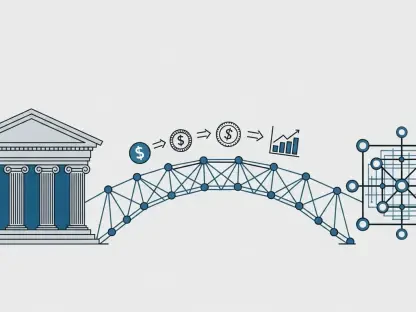Tokenization is emerging as a potential game-changer in the global financial system, promising to revolutionize how we store, transfer, and manage value. This innovative process involves converting ownership rights of various assets into digital tokens that reside on a blockchain. As financial institutions grapple with disruptions spurred by digital currencies and blockchain technology, tokenization could herald a new era of efficiency, security, and financial inclusivity. This transformation is already making waves in different sectors, suggesting that its wide-scale adoption could fundamentally alter the landscape of global finance.
The Evolution of Money and Payment Systems
From the barter system to the use of coins, paper money, and electronic balances, the methods of storing and transferring value have continuously evolved. Digitalization of money in bank databases has been the norm, but the advent of blockchain technology introduces the next phase: tokenization. By converting assets into digital tokens, monetary transactions can become faster, more transparent, and more secure. Blockchain’s decentralized and immutable nature helps in maintaining the integrity and transparency of these transactions. As monetary systems advance, tokenization could serve as the bridge connecting traditional and digital finance.
Tokenization builds on the digital foundation established by electronic banking. Traditional banking systems use ledgers to keep track of transactions, a process that can be slow and prone to errors. In contrast, blockchain-based tokenization operates on a shared ledger that is immutable and programmable, drastically reducing the potential for fraud and improving transaction efficiency. Smart contracts add an extra layer of security and automation, completing transactions based on pre-set conditions without requiring human intervention. This advancement positions tokenization as a useful tool for enhancing the security and efficiency of financial systems.
With the increasing digitization of money, consumers and businesses are already accustomed to electronic payments and transfers. The logical next step is tokenization, where each token represents a specific asset and is governed by predefined rules encoded in smart contracts. This shift could streamline everyday banking operations, from liquidity management to fund transfers. The adaptability of tokenization to various types of assets, whether it be real estate, stocks, or commodities, indicates its wide application potential. This could lead to a more integrated and efficient financial ecosystem where the movement of assets is not only faster but also more secure.
Benefits of Tokenization in Banking
The adoption of tokenization in banking offers numerous benefits, chief among them programmability. Unlike traditional digital assets, tokenized assets can be managed through smart contracts that automate various financial processes. For example, smart contracts can execute fund transfers or settlement processes instantly, without manual intervention, thereby minimizing delays and errors. This automation significantly reduces administrative costs and the risks associated with manual handling. As financial institutions continue to seek more efficient ways of conducting their operations, the programmability of tokenized assets stands out as a crucial advantage.
Another major advantage is instant settlement. Currently, many financial transactions require several days to settle, especially in international contexts. Tokenization enables real-time settlements, reducing the time and cost of transactions. This can be particularly beneficial for cross-border payments, which traditionally incur high fees and time lags. By enabling instant settlement, tokenization not only speeds up the transfer of assets but also enhances liquidity within the financial system. This can have a ripple effect, reducing the costs of borrowing and encouraging more dynamic market activities.
Atomic settlement is yet another benefit of tokenized transactions. This means both sides of a transaction are executed simultaneously, eliminating the risk of one party defaulting after receiving the asset or capital. By ensuring that transactions are either entirely completed or not executed at all, atomic settlement can significantly reduce counterparty risks. This feature can be particularly valuable in high-value financial trades where the stakes are incredibly high. The aggregation of these benefits positions tokenization not just as an incremental improvement but a profound transformation in how financial systems operate.
Challenges and Risks of Tokenization
Despite its advantages, tokenization is not without its challenges. The transition to a tokenized system necessitates solving complex technological questions, including global blockchain interoperability and robust cybersecurity measures. Financial institutions will need to invest in new technologies and expertise to make these transitions seamless. Moreover, the technical complexities associated with ensuring that different blockchain platforms can interact fluidly cannot be understated. This interoperability is crucial for widespread adoption, as it would enable a cohesive and efficient global financial system.
Legal and regulatory hurdles pose another significant challenge. The global financial system is governed by various regulatory frameworks that are not yet equipped to deal with tokenized assets. Differing regional laws and tax regimes further complicate the adoption of a standardized global tokenization system. Regulators will need to evolve and create new frameworks that can accommodate the nuances of digital assets. Until such frameworks are established, the risk of legal challenges and compliance issues remains a significant barrier to the widespread adoption of tokenization.
Operational risks are also a notable concern. Financial institutions adopting tokenization must ensure their systems are resilient against hacking and other cybersecurity threats. Additionally, they must maintain the integrity and performance of their blockchain networks to ensure seamless and uninterrupted service. This calls for an enormous amount of resources and technological know-how, often requiring collaboration with blockchain experts and cybersecurity firms. As institutions venture into this new territory, the challenges related to operational risks should not be underestimated.
Real-World Examples and Case Studies
One of the most compelling examples of tokenization in action is China’s digital yuan. As a state-backed digital currency, it demonstrates the transformative potential of tokenization on a large scale. The digital yuan facilitates real-time transactions across various platforms, setting a benchmark for other nations contemplating similar initiatives. It has already seen significant use in domestic transactions, amounting to 100 billion yuan. This serves as a real-world example of how digital currencies and tokenized assets can function effectively at a national level, providing valuable insights for other countries exploring similar paths.
The recent collapse of FTX and the subsequent banking crisis in 2023 highlight the risks and challenges associated with digital assets. These events underscore the necessity for robust regulatory oversight and risk management practices. Despite these challenges, financial institutions and regulators are increasingly recognizing the need to explore and understand tokenization. The fallout from such crises proves that due diligence, strong regulatory frameworks, and transparent operations are critical for the trust and stability of tokenized financial systems.
Stablecoins, such as Tether, offer another perspective on the market dynamics of tokenization. Tether is the most traded digital asset, illustrating both the promise and peril of such financial instruments. While stablecoins can offer stability and efficiency, the need for transparency and regulation to prevent misuse in illicit transactions remains critical. Tether’s case also highlights the importance of regulatory scrutiny and compliance, as its systemic importance becomes more pronounced. Financial actors must strike a balance between innovation and regulatory adherence to ensure sustainable growth.
Regulatory and Global Standards
Tokenization is emerging as a potential game-changer in the global financial system, poised to revolutionize how we store, transfer, and manage value. By converting ownership rights of various assets into digital tokens that exist on a blockchain, this innovative process is setting the stage for greater efficiency, security, and financial inclusivity. Financial institutions are already dealing with the disruptions caused by digital currencies and blockchain technology, and tokenization represents the next step in this evolution. It offers a new way to handle assets, making transactions faster and more secure while lowering the potential for fraud. This transformation is not limited to one sector; rather, it is making significant impacts across various industries, suggesting that its wide-scale adoption could fundamentally reshape the landscape of global finance. As different sectors adopt tokenization, we are likely to see more transparent and accessible financial systems, potentially democratizing access to investment opportunities and creating a more inclusive global economy.









